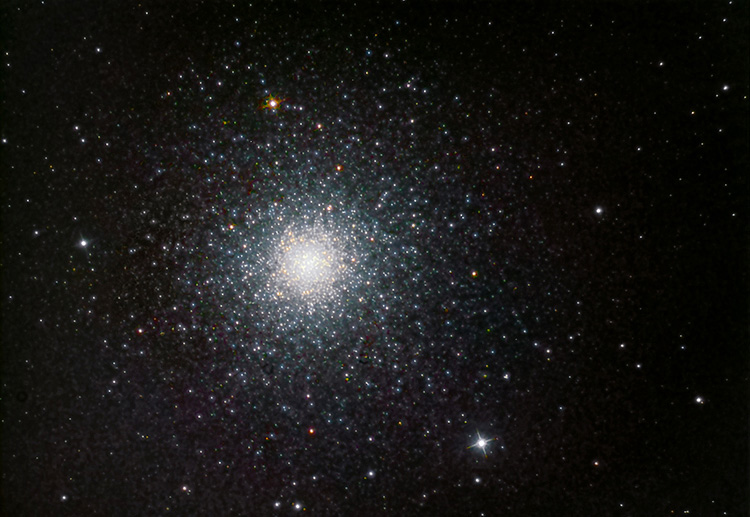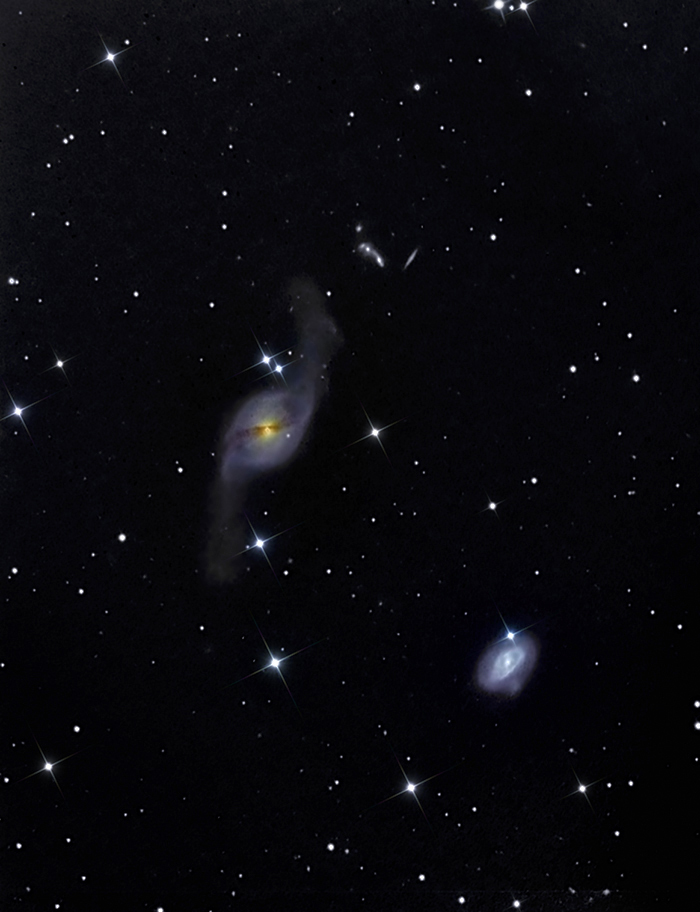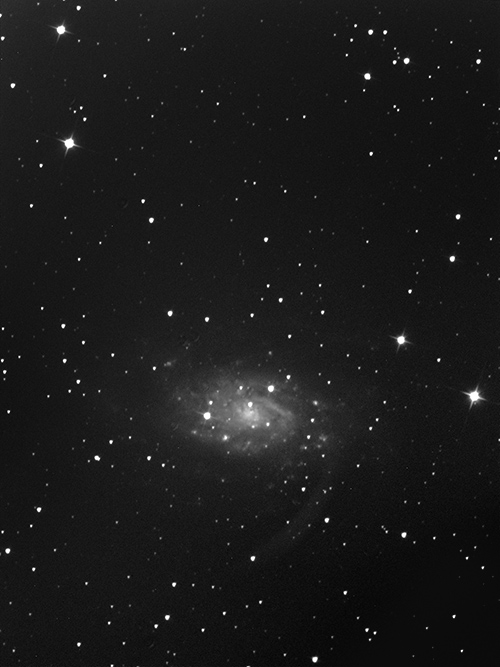04/21/2013. I intended to work more on the Trio, but I found the waxing gibbous Moon parked almost on top of the field. M100 was my next choice, but too much haze, bright moonlight, and inconveniently placed trees ended that idea. I captured a series of unguided frames of Capella followed by 90 minutes of H-a (900s at a whack) to use to sweeten the star-forming regions of M81, and then I settled on M3 for the night. Guiding was superb (0.8 second of arc RMS corrections using 20s integrations to guide on a 12th magnitude star all night long) though the seeing was mediocre. I used a Bahtinov mask to focus on Pollux before slewing to M3. Then I took PSF measurements to confirm that the mask had put me well within 5 Robofocus units of the point of best focus. Every micron matters, and the mask works very well! Here's 4 hours total exposure (mind, 30 seconds with the CCD produces a better image of M3 than any I got back in the days of film):

M3
AT10RC @ F4.8
39x300s L
, 3x300s RGB
(total 3h15m L, 15m each RGB; 4 hours total)
I would have had another 30 minutes or so to add to that image, except that I forgot to plug in the netbook that tends the telescope. Just as I began to close up the desktop to go to bed, the communications link dropped, and I knew immediately what had happened. House slippers, bathrobe, flashlight... Between rebooting the computer, re-initalizing the camera drivers and firmware, restarting the imaging software, recalibrating the guider and resetting this and that, I lost about half an hour of data (and an hour's sleep). After that, I had the telescope take 5-minute sips until morning. Note that the faintest stars visible in the extended halo around M3 -- the faint little guys halfway across the frame from the core, the ones you have to squint to find -- are still on the order of 25-50x brighter than the Sun.
04/22/2013: Moony, hazy, but I wanted to shoot something other than the usual suspects in the mid-spring sky. So I looked in the area near M81 because it clears Bird Feeder Tree soonest and objects there remain available for longer exposures than do objects in the rest of the sky. In Guide 9, I found this interesting group of galaxies arrayed around NGC 3718:

NGC 3718 (and Hickson 56)
16x900s L, 1x900s RGB (4h45m total)
AT10RC F4.8
This is a glimpse of the very deep sky. Galaxies in this field range from about 56,000,000 light-years away (the bright blue ring galaxy at lower right, NGC 3729), to 120,000,000 ly (the large, tidally distorted galaxy at left center, NGC 3718) to 340 - 370,000,000 ly (the compact cluster just above and right of NGC 3718, Hickson 56). Note that I also find several sources -- APOD among them -- which suggest that 3718 and 3729 are interacting, and so must be at about the same distance, about 56M ly.
Bright moonlight and thin data made processing this one a lot of work. I could only dimly see the stars of the Big Dipper. The brightest star in this field, near the top edge, is 10th magnitude. The rest are 11th or fainter. The CCD's guide chip used an 11.4 magnitude star and 10s integrations. I've applied the thin and gradient-plagued RGB data only to the galaxies and brightest stars. Russell Croman's Gradient Exterminator earned its keep. I sweetened the diffraction spikes around field stars with StarSpikes Pro2 -- handling the data so aggressively blunted the originals. Let's call it a study for an eventual deepsky photograph. Pile up a lot more light under better conditions, and then we'll see how this looks with, oh, 15 or 20 hours of exposure. (The CCD is oriented about 90 degrees CCW from what I think of as 1st position which is where the CFW-8a's motor housing just clears the RoboFocus motor; take the adapters to a jeweler and engrave a scale or print something to glue to the mounting plate of the CFW).
To belabor a point or two: the sky was so bright (How bright was it?) that 900s L exposures had sky "background" levels in the 20-25k range. If the name of the game is S/N, I have to wonder if there is a relatively straightforward way to compute the exposure time required under bright sky conditions (due to the Moon, or Charlotte, or Albuquerque) to produce similar results from exposures under dark sky conditions (e.g., Chaco, Datil, Quemado, City of Rocks). S/N can be predicted and might be a decent proxy for overall image quality. I think SQMeter readings could be more or less easily used for this calculation, as could flux measurements pulled directly from sample images:
Signal (= ObjectFlux * Time * Aperture) / Noise (= sqrt(Signal + SkyGlow))
For an instructive formula, solve for Time, the only variable under my control. You need to be very careful with these calculations. I don't mean with units and so forth. I mean that using them carelessly could end up costing a fortune in remote real estate and travel (and in improving detector efficiency, see the webpage from which I lifted the expression).
4/25/2013. If I have done the math right, then the exposure time required to get the same s/n under different sky brightnesses is simply proportional to the ratio of sky brightnesses. I.e, if the sky is 4x as bright, you need 4x the exposure. I'm doing some deepsky stuff under the Full Moon tonight. These images will provide near-worst-case data. Compare the statistics gathered by Maxim to images of the same field shot on a darker night and see if the simple proportion is plausible.
On a dark night here, a SQMeter reading of 18.5 is typical. At Datil Well, I saw 21.5 and 21.7 at various times of the night. Just to be conservative about this, let's take 21.3 as a plausible Datil sky brightness, a difference of 2.8 magnitudes. So the sky flux here is brighter by the fifth root of one hundred raised to the 2.8th power, and to produce images of the same S/N at the two locations, the exposure times must differ by the same factor. That factor is 13.2. To get the same image I could get at Datil Well in 2 hours would take 26.4 hours here. Or, to produce the same quality in the same time would take a telescope the square root of 13.2 larger in aperture (a 10-inch scope there can do what a 32- or 36-incher can do here). It's not quite that bad. Combining a lot of subframes knocks down electronic noise, satellites, and the effects of isolated guiding excursions, so in that sense I'd rather combine dozens of subframes rather than four or five. And by the time images are ready for display as 8-bit JPEGs or printed by any available technology, some of the low-bit subtleties will inevitably have been tossed. But still.
[It's actually a bit worse than that, since read noise will increase owing to the multiple exposures, and the longer exposure time will also record additional instrument noise. Instead of a factor of 13.2, somethiing like a factor of 18-20 might be more realistic. dc 20151024]
Test all this by examining background readings from deep sky images made under moonlit and moonfree conditions; compare the statistical and aesthetic characteristics of those images. Keep in mind that the budgets for an RC on the order of a yard wide and a classy domicile under black New Mexican skies are remarkably similar (and similarly attainable or unattainable as the case may be).
Anyways. I added 5 hours of Moonstruck luminance data to the NGC 3718 image, and while waiting for NGC 3718 to come out of the trees, I took 1h15m of a big, close spiral that gets little attention: NGC 2403. The absolutely full Moon (partial eclipse before moonrise) was rising higher as I made these frames, and the background count was pushing 30,000 (note: this CCD has a full-well capacity of about 45,000 electrons and is an anti-blooming device; the sky brightness alone may be sneaking up on the point where the antiblooming feature begins to matter).

NGC 3718 & Hickson 56
36x900s L, 1x900s RGB (9h45m total)
(Full moonlight)

NGC 2403
5x900s L (1h15m)
Full moonlight.
Except where noted, deep-sky photos are made with an SBIG ST2000XM CCD behind a 10-inch Astro-Tech Ritchey-Chretien carried on an Astro-Physics Mach1GTO. The CCD is equipped with Baader LRGB and 7nm H-a filters. The internal guide chip of the CCD most often keeps the OTA pointed in the right direction (I'll let you know when a Meade DSI and a separate OAG or guidescope takes its place). Camera control and guiding are handled by Maxim DL 5.12. The stock focuser on the AT10RC has been augmented with Robofocus 3.0.9 using adapters turned on the lathe downstairs. Maxim performs image calibration, alignment, and stacking; Photoshop CS4 and FocusMagic 3.0.2 take it from there. Gradient Xterminator by Russell Croman and Astronomy Tools by Noel Carboni see their share of work, too. Beginning in May 2013, PixInsight has taken over some of the heavy lifting for transfer function modification and deconvolution.
:: top ::